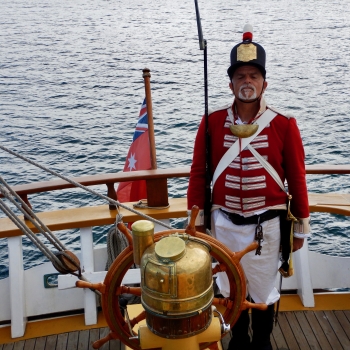The original Lady Nelson was built at Deptford, in England, in 1799, for service to the Transport Office on the River Thames.
She was designed with sliding keels (centre boards), a device invented by Captain John Schank of the Royal Navy to allow surveying in rivers and shallow water ways.
On completion she was selected for exploration services in the Colony of New South Wales and sailed for Port Jackson on 18 March 1800 under the command of Lieutenant James Grant.
A brig of 60 tons, she carried a crew comprising the commander, two mates and twelve seaman.
As she left the River Thames sailors on nearby ships ridiculed her because of her size and shape, calling her, as she sailed past, 'His Majesty's Tinderbox'.
At Portsmouth on the 9th February 1800 she was fitted with four brass carriage guns, three to four pounders, in addition to the two guns already on board.
Because of the heavy load she was carrying she was very low in the water, having only two feet nine inches freeboard amidships.
The ship finally left Portsmouth on 17th March 1800 as part of an East Indian Convoy.
From 1800 to 1825 the Lady Nelson operated around the Australian Coast and fulfilled a variety of roles including exploration, surveying, forming settlements, shifting goods and people around the colonies and capturing pirates.
She played pivotal roles in the European settlement of Hobart, Northern Tasmania, Melbourne, Newcastle, Port Macquarie and Northern Territory.
Those onboard charted much of Bass Strait, Port Philip, Newcastle, Port Macquarie and (with the Investigator) the coasts of northern New South Wales and southern Queensland.
She also has links to other locations around the East Coast such as Trial Bay in NSW and the Mt Gambier area of SA.
After 25 years of service while trading on the island of Baba the Lady Nelson was overrun by the islanders, the crew was killed and the ship stripped and later burnt and sunk.

